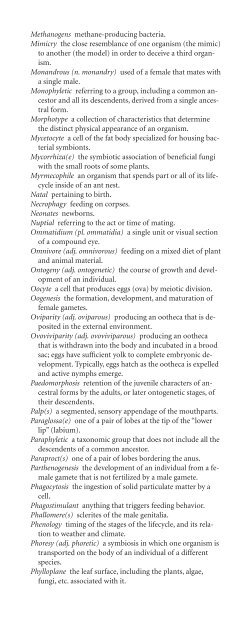Cockroache; Ecology, behavior & history - W.J. Bell
Cockroache; Ecology, behavior & history - W.J. Bell
Cockroache; Ecology, behavior & history - W.J. Bell
Create successful ePaper yourself
Turn your PDF publications into a flip-book with our unique Google optimized e-Paper software.
Methanogens methane-producing bacteria.<br />
Mimicry the close resemblance of one organism (the mimic)<br />
to another (the model) in order to deceive a third organism.<br />
Monandrous (n. monandry) used of a female that mates with<br />
a single male.<br />
Monophyletic referring to a group, including a common ancestor<br />
and all its descendents, derived from a single ancestral<br />
form.<br />
Morphotype a collection of characteristics that determine<br />
the distinct physical appearance of an organism.<br />
Mycetocyte a cell of the fat body specialized for housing bacterial<br />
symbionts.<br />
Mycorrhiza(e) the symbiotic association of beneficial fungi<br />
with the small roots of some plants.<br />
Myrmecophile an organism that spends part or all of its lifecycle<br />
inside of an ant nest.<br />
Natal pertaining to birth.<br />
Necrophagy feeding on corpses.<br />
Neonates newborns.<br />
Nuptial referring to the act or time of mating.<br />
Ommatidium (pl. ommatidia) a single unit or visual section<br />
of a compound eye.<br />
Omnivore (adj. omnivorous) feeding on a mixed diet of plant<br />
and animal material.<br />
Ontogeny (adj. ontogenetic) the course of growth and development<br />
of an individual.<br />
Oocyte a cell that produces eggs (ova) by meiotic division.<br />
Oogenesis the formation, development, and maturation of<br />
female gametes.<br />
Oviparity (adj. oviparous) producing an ootheca that is deposited<br />
in the external environment.<br />
Ovoviviparity (adj. ovoviviparous) producing an ootheca<br />
that is withdrawn into the body and incubated in a brood<br />
sac; eggs have sufficient yolk to complete embryonic development.<br />
Typically, eggs hatch as the ootheca is expelled<br />
and active nymphs emerge.<br />
Paedomorphosis retention of the juvenile characters of ancestral<br />
forms by the adults, or later ontogenetic stages, of<br />
their descendents.<br />
Palp(s) a segmented, sensory appendage of the mouthparts.<br />
Paraglossa(e) one of a pair of lobes at the tip of the “lower<br />
lip” (labium).<br />
Paraphyletic a taxonomic group that does not include all the<br />
descendents of a common ancestor.<br />
Paraproct(s) one of a pair of lobes bordering the anus.<br />
Parthenogenesis the development of an individual from a female<br />
gamete that is not fertilized by a male gamete.<br />
Phagocytosis the ingestion of solid particulate matter by a<br />
cell.<br />
Phagostimulant anything that triggers feeding <strong>behavior</strong>.<br />
Phallomere(s) sclerites of the male genitalia.<br />
Phenology timing of the stages of the lifecycle, and its relation<br />
to weather and climate.<br />
Phoresy (adj. phoretic) a symbiosis in which one organism is<br />
transported on the body of an individual of a different<br />
species.<br />
Phylloplane the leaf surface, including the plants, algae,<br />
fungi, etc. associated with it.<br />
Polyandrous (n. polyandry) used of a female that mates with<br />
more than one male.<br />
Polyphenism the condition of having discontinuous phenotypes<br />
that lack genetic fixation.<br />
Proctodeal referring to the hindgut.<br />
Pronotum the first dorsal division of the thorax.<br />
Protibiae the tibiae of the first set of legs.<br />
Proventriculus the gizzard.<br />
Pseudopenis an intromittent type male genital appendage<br />
that does not function to transfer sperm.<br />
Pterothoracic referring to the wing-bearing segments of the<br />
thorax.<br />
Quiescence a resting phase that occurs in direct response to<br />
deleterious physical conditions; it is terminated when conditions<br />
improve.<br />
Rhizosphere the zone surrounding plant roots.<br />
Sclerite a hardened plate of the exoskeleton bounded by sutures<br />
or membranous areas.<br />
Sclerotized hardened.<br />
Semelparous a life <strong>history</strong> where an organism reproduces<br />
just once in its lifetime.<br />
Semi-voltine used of taxa that require 2 yr to develop to the<br />
adult stage of the lifecycle.<br />
Seta(e) a bristle.<br />
Spermatheca a receptacle for sperm storage in females.<br />
Spermatophore a capsule containing sperm that is transferred<br />
from the male to the female during copulation.<br />
Spiracle an external opening of the tracheal system; breathing<br />
pore.<br />
Stadium the period between molts in a developing arthropod.<br />
Sternal gland a gland on the ventral surface of the abdomen.<br />
Stigmatic referring to the stigma, the upper end of the pistil<br />
in a flower.<br />
Stomodeal referring to the foregut.<br />
Subgenital plate a plate-like sclerite that underlies the genitalia.<br />
Subsocial the condition in which one or both parents care<br />
for their own young.<br />
Tarsus (pl. tarsi) the leg segment distally adjacent to the<br />
tibia; may be subdivided into segments (tarsomeres).<br />
Taxon (pl. taxa) any group of organisms, populations, or<br />
taxonomic groups considered to be sufficiently distinct<br />
from other such groups as to be treated as a separate unit.<br />
Tegmen (pl. tegmina) the thickened or leathery front wing of<br />
cockroaches and other orthopteroid insects.<br />
Teneral a term applied to a recently molted, pale, soft-bodied<br />
arthropod.<br />
Tergal glands glands on the dorsal surface of the abdomen;<br />
usually referring to those on males that entice females into<br />
position for copulatory engagement.<br />
Tergite a sclerite of the dorsal surface of the abdomen.<br />
Termitophile an organism that spends part or all of its lifecycle<br />
inside of a termite nest.<br />
Thigmotaxis (adj. thigmotactic) a directed response of a<br />
motile organism to continuous contact with a solid surface.<br />
Thorax the body region, located behind the head, which<br />
bears the legs and wings.<br />
GLOSSARY 181


